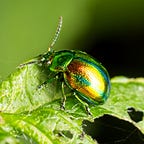Photographing Insects: Landscapes or Portraits?
Two rather different ways to photograph insects
No, I am not talking about the orientation of your camera. I am talking about what you are actually photographing. Are you shooting a wider “landscape” that contains an insect, or are you taking a portrait of an insect? Let us look into these rather different approaches.
When I viewed photographs by many professional (insect) photographers, I noticed that, often, the insect is just a prop in their image. The total composition is what matters. And sometimes, they look down on shots that “just” show the insect. I think we talk about two different styles of photography though.
Landscapes
Consider the image below, that I took from Unsplash. I consider this a “landscape” photo of an insect. Clearly, there is an insect in the picture. But the photo is really about the composition of the sharp flower in the foreground and the other blurred flowers in the background.
The insect primarily serves as a point to focus the attention of the viewer. You might argue that the insect is not even necessary to make this an interesting shot, although I think that without it, the picture would have been a bit dull. (I would have removed the yellow blob near the bottom edge to improve the composition.)
But this insect is clearly not the topic of the image. It is not even completely clear what type of insect it is. (I think it is an ant.) It is also not shown in the most flattering way, as it is looking away from the viewer. The insect is basically a prop.
So, is this an insect shot? For comparison, let us look at photographing people. I think that an equivalent picture would be the image below of a path in a forest, and on the path, there is a hiker. It is a shot of the forest and the winding path. The person adds an attention point to it and might give it a bit more meaning. But also without the hiker, it could be a nice shot (although I would have used a narrower aperture to make the background sharper). Is this a “person shot”?
There is absolutely nothing wrong with such “landscape” insect shots. But I am a bit surprised that I regularly read that those are the true artistic insect pictures, while shots that primarily show the insects are “just” registrations, which is clearly meant negatively. Would you say that of portraits of people?
Portraits
Other insect photographers, including myself, focus primarily on the insect itself. Most of the image will be filled by the insect, although some of the environment might be shown, like part of the flower that a butterfly is eating nectar from. The environment serves the insect in the shot, not the other way around. Sometimes only a close-up of part of the insect is shown. I like to call these insect portraits.
The goal of such a shot is to show the beauty or weirdness of the insect itself. The photo catches the attention of the viewer because of the unexpectedness, or its abundance of color or detail.
Now, some of these shots are indeed “just registrations”. They are taken with the purpose of remembering what you saw and, maybe, to identify the insect later. It is the equivalent of a passport photograph of a person. People take registration shots all the time. For most people, this is the prime goal of their photography: to remember objects, locations, or events later.
But insect portraits can be so much more, and it has a lot in common with photographing human portraits. You use some of the same techniques, like dealing with lighting, shooting angles, focus, backgrounds, and so on.
There are of course also large differences. You have much less control over the circumstances, and you cannot give instructions to your “model”. Also, there is much less of an emotional connection with the subject. On the other hand, there is so much more variation in subject matter with amazing intricacy, which allows for all sorts of fascinating photos.
I think insect portraits should get more attention. They should not just be seen as technical macro achievements, but be appreciated by the way they portray their subjects.
Mark Overmars is a dedicated insect photographer who loves to share and regularly publishes about his work and about photography in general. You can visit his website at www.insectphotography.org. Download his free insect photography book at www.insectphotography.org/book.
